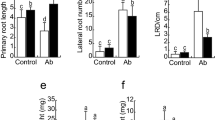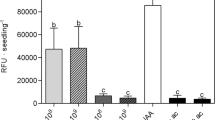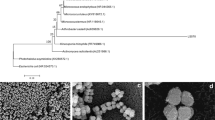Abstract
Plant growth promoting rhizobacteria influence host functional and adaptive traits via complex mechanisms that are just started to be clarified. Azospirillum brasilense acts as a probiotic bacterium, but detailed information about its molecular mechanisms of phytostimulation is scarce. Three interaction systems were established to analyze the impact of A. brasilense Sp245 on the phenotype of Arabidopsis seedlings, and underlying molecular responses were assessed under the following growth conditions: (1) direct contact of roots with the bacterium, (2) chemical communication via diffusible compounds produced by the bacterium, (3) signaling via volatiles. A. brasilense Sp245 improved shoot and root biomass and lateral root production in the three interaction systems assayed. Cell division, quiescent center, and differentiation protein reporters pCYCB1;1::GUS, WOX5::GFP, and pAtEXP7::GUS had a variable expression in roots depending of the nature of interaction. pCYCB1;1::GUS and WOX5::GFP increased with volatile compounds, whereas pAtEXP7::GUS expression was enhanced towards the root tip in plants with direct contact with the bacterium. The auxin reporter DR5::GUS was highly expressed with diffusible and volatile compounds, and accordingly, auxin signaling mutants pin3, slr1, arf7arf19, and tir1afb2afb3 showed differential phytostimulant responses when compared with the wild type. By contrast, ethylene signaling was not determinant to mediate root changes in response to the different interactions, as observed using the ethylene-related mutants etr1, ein2, and ein3. Our data highlight the diverse effects by which A. brasilense Sp245 improves plant growth and root architectural traits and define a critical role of auxin but not ethylene in mediating root response to bacterization.





Similar content being viewed by others
References
Aichinger E, Kornet N, Friedrich T, Laux T (2012) Plant stem cell niches. Ann Rev Plant Biol 63:615–636. https://doi.org/10.1146/annurev-arplant-042811-105555
Bashan Y, de-Bashan LE (2010) How the plant growth-promoting bacterium Azospirillum promotes plant growth - a critical assessment. Adv Agro 108:77–136. https://doi.org/10.1016/S0065-2113(10)08002-8
Blilou I, Xu J, Wildwater M, Willemsen V, Paponov I, Friml J, Heidstra R, Aida M, Palme K, Scheres B (2005) The PIN auxin efflux facilitator network controls growth and patterning in Arabidopsis roots. Nature 433:39–44. https://doi.org/10.1038/nature03184
Bottini R, Fulchieri M, Pearce D, Pharis RP (1989) Identification of gibberellins a(1), a(3), and iso-a(3) in cultures of Azospirillum lipoferum. Plant Physiol 90:45–47. https://doi.org/10.1104/pp.90.1.45
Bottini R, Cassán F, Piccoli P (2004) Gibberellin production by bacteria and its involvement in plant growth promotion and yield increase. Appl Microbiol Biotechnol 65:497–503. https://doi.org/10.1007/s00253-004-1696-1
Cassan F, Diaz-Zorita M (2016) Azospirillum sp. in current agriculture: from the laboratory to the field. Soil Biol Biochem 103:117–130. https://doi.org/10.1016/j.soilbio.2016.08.020
Cassan F, Vanderleyden J, Spaepen S (2014) Physiological and agronomical aspects of phytohormone production by model plant-growth-promoting rhizobacteria (PGPR) belonging to the genus Azospirillum. J Plant Growth Reg 33:440–459. https://doi.org/10.1007/s00344-013-9362-4
Chao Q, Rothenberg M, Solano R, Roman G, Terzaghi W, Ecker JR (1997) Activation of the ethylene gas response pathway in Arabidopsis by the nuclear protein ETHYLENE-INSENSITIVE3 and related proteins. Cell 89:1133–1144. https://doi.org/10.1016/s0092-8674(00)80300-1
Cho HT, Cosgrove DJ (2002) Regulation of root hair initiation and expansin gene expression in Arabidopsis. Plant Cell 14:3237–3253. https://doi.org/10.1105/tpc.006437
Cohen AC, Bottini R, Piccoli PN (2008) Azospirillum brasilense Sp245 produces ABA in chemically-defined culture medium and increases ABA content in Arabidopsis plants. Plant Growth Reg 54:97–103. https://doi.org/10.1007/s10725-007-9232-9
Cohen AC, Bottini R, Pontin M, Berli FJ, Moreno D, Boccanlandro H, Travaglia CN, Piccoli PN (2015) Azospirillum brasilense ameliorates the response of Arabidopsis thaliana to drought mainly via enhancement of ABA levels. Physiol Plant 153:79–90
Colón-Carmona A, You R, Haimovitch-Gal T, Doerner P (1999) Spatio-temporal analysis of mitotic activity with a labile cyclin-GUS fusion protein. Plant J 20:503–508. https://doi.org/10.1046/j.1365-313x.1999.00620.x
Delaplace P, Delory BM, Baudson C, Mendaluk-Saunier de Cazenave M, Spaepen S, Varin S, Brostaux Y, du Jardin P (2015) Influence of rhizobacterial volatiles on the root system architecture and the production and allocation of biomass in the model grass Brachypodium distachyon (L.) P. Beauv. BMC Plant Biol 15:195. https://doi.org/10.1186/s12870-015-0585-3
Dello Ioio R, Linhares FS, Scacchi E, Casamitjana-Martinez E, Heidstra R, Costantino P, Sabatini S (2007) Cytokinins determine Arabidopsis root-meristem size by controlling cell differentiation. Curr Biol 17:678–682. https://doi.org/10.1016/j.cub.2007.02.047
Dello Ioio R, Nakamura K, Moubayindin L, Perilli S, Taniguchi M, Morita MT, Aoyama T, Costantino P, Sabatini S (2008) A genetic framework for genetic control of cell division and differentiation in the root meristem. Science 322:1380–1384. https://doi.org/10.1126/science.1164147
Dharmasiri N, Dharmasiri S, Weijers D, Lechner E, Yamada M, Hobbie L, Ehrismann JS, Jürgens G, Estelle M (2005) Plant development is regulated by a family of auxin receptor F box proteins. Dev Cell 9:109–119. https://doi.org/10.1016/j.devcel.2005.05.014
Dobbelaere S, Croonenborghs A, Thys A, Broek AV, Vanderleyden J (1999) Phytostimulatory effect of Azospirillum brasilense wild type and mutant strains altered in IAA production on wheat. Plant Soil 212:155–164. https://doi.org/10.1023/A:1004658000815
Dubrovsky JG, Puente ME, Bashan Y (1994) Arabidopsis thaliana as a model system for the study of the effect of inoculation by Azospirillum brasilense Sp-245 on root hair growth. Soil Biol Biochem 26:1657–1664. https://doi.org/10.1016/0038-0717(94)90318-2
Forzani C, Aichinger E, Sornay E, Willemsen V, Laux T, Dewitte W, Murray JAH (2014) WOX5 suppresses CYCLIN D activity to establish quiescence at the center of the root stem cell niche. Curr Biol 24:1939–1944. https://doi.org/10.1016/j.cub.2014.07.019
Friml J, Wisniewska J, Benková E, Mendgen K, Palme K (2002) Lateral relocation of auxin efflux regulator PIN3 mediates tropism in Arabidopsis. Nature 415:806–809. https://doi.org/10.1038/415806a
Fukaki H, Tameda S, Masuda H, Tasaka M (2002) Lateral root formation is blocked by a gain-of-function mutation in the SOLITARY-ROOT/IAA14 gene of Arabidopsis. Plant J 29:153–168. https://doi.org/10.1046/j.0960-7412.2001.01201.x
Guzmán P, Ecker JR (1990) Exploiting the triple response of Arabidopsis to identify ethylene-related mutants. Plant Cell 2:513–523. https://doi.org/10.1105/tpc.2.6.513
Hua J, Meyerowitz EM (1998) Ethylene responses are negatively regulated by a receptor gene family in Arabidopsis thaliana. Cell 94:261–271. https://doi.org/10.1016/s0092-8674(00)81425-7
Kai M, Piechulla B (2009) Plant growth promotion due to rhizobacterial volatiles - an effect of CO2? FEBS Lett 583:3473–3477. https://doi.org/10.1016/j.febslet.2009.09.053
Kanchiswamy CN, Malnoy M, Maffei ME (2015) Chemical diversity of microbial volatiles and their potential for plant growth and productivity. Front Plant Sci 6:151. https://doi.org/10.3389/fpls.2015.00151
López-Bucio J, Campos-Cuevas JC, Hernández-Calderón E, Velásquez-Becerra C, Farías-Rodríguez R, Macías-Rodríguez LI, Valencia-Cantero E (2007) Bacillus megaterium rhizobacteria promote growth and alter root-system architecture through an auxin- and ethylene-independent signaling mechanism in Arabidopsis thaliana. Mol Plant-Microbe Inter 20:207–217. https://doi.org/10.1094/MPMI-20-2-0207
Lugtenberg B, Kamilova F (2009) Plant-growth-promoting rhizobacteria. Ann rev Microbiol 63:541–556. https://doi.org/10.1146/annurev.micro.62.081307.162918
Malamy JE, Benfey PN (1997) Organization and cell differentiation in lateral roots of Arabidopsis thaliana. Development 124:33–44
Masle J (2000) The effects of elevated CO2 concentrations on cell division rates, growth patterns, and blade anatomy in young wheat plants are modulated by factors related to leaf position, vernalization, and genotype. Plant Physiol 122:1399–1415. https://doi.org/10.1104/pp.122.4.1399
Murashige T, Skoog F (1962) A revised medium for rapid growth and bio assays with tobacco tissue cultures. Physiol Plant 15:473–497
Niu Y, Jin C, Jin G, Zhou Q, Lin X, Tang C, Zhang Y (2011) Auxin modulates the enhanced development of root hairs in Arabidopsis thaliana (L.) Heynh. Under elevated CO2. Plant Cell Environ 34:1304–1317. https://doi.org/10.1111/j.1365-3040.2011.02330
Ohto M, Onai K, Furukawa Y, Aoki E, Araki T, Nakamura K (2001) Effects of sugar on vegetative development and floral transition in Arabidopsis. Plant Physiol 127:252–261. https://doi.org/10.1104/pp.127.1.252
Okushima Y, Overvoorde PJ, Arima K, Alonso JM, Chan A, Chang C, Ecker JR, Hughes B, Lui A, Nguyen D, Onodera C, Quach H, Smith A, Yu G, Theologis A (2005) Functional genomic analysis of the AUXIN RESPONSE FACTOR gene family members in Arabidopsis thaliana: unique and overlapping functions of ARF7 and ARF19. Plant Cell 17:444–463. https://doi.org/10.1105/tpc.104.028316
Okushima Y, Fukaki H, Onoda M, Theologis A, Tasaka M (2007) ARF7 and ARF19 regulate lateral root formation via direct activation of LBD / ASL genes in Arabidopsis. Plant Cell 19:118–130. https://doi.org/10.1105/tpc.106.047761
Pérez-Flores P, Valencia-Cantero E, Altamirano-Hernández J, Pelagio-Flores R, López-Bucio J, García-Juárez P, Macías-Rodríguez L (2017) Bacillus methylotrophicus M4-96 isolated from maize (Zea mays) rhizoplane increases growth and auxin content in Arabidopsis thaliana via emission of volatiles. Protoplasma 254:2201–2213. https://doi.org/10.1007/s00709-017-1109-9
Petricka JJ, Winter CM, Benfey PN (2012) Control of Arabidopsis root development. Ann Rev Plant Biol 63:563–590. https://doi.org/10.1146/annurev-arplant-042811-105501
Ryu CM, Farag MA, Hu CH, Reddy MS, Wei HX, Paré PW, Kloepper JW (2003) Bacterial volatiles promote growth in Arabidopsis. Proc Natl Acad Sci U S A 100:4927–4932. https://doi.org/10.1073/pnas.0730845100
Ryu CM, Farag MA, Hu CH, Reddy MS, Kloepper JW, Paré PW (2004) Bacterial volatiles induced resistance in Arabidopsis. Plant Physiol 134:1017–1026. https://doi.org/10.1104/pp.103.026583
Sarkar AK, Luijten M, Miyashima S, Lenhard M, Hashimoto T, Nakajima K, Scheres B, Heidstra R, Laux T (2007) Conserved factors regulate signalling in Arabidopsis thaliana shoot and root stem cell organizers. Nature 446:811–814. https://doi.org/10.1038/nature05703
Spaepen S, Dobbelaere S, Croonenborghs A, Vanderleyden J (2008) Effects of Azospirillum brasilense indole-3-acetic acid production on inoculated wheat plants. Plant Soil 312:15–23. https://doi.org/10.1007/s11104-008-9560-1
Spaepen S, Bossuyt S, Engelen K, Marchal K, Vanderleyden J (2014) Phenotypical and molecular responses of Arabidopsis thaliana roots as a result of inoculation with the auxin-producing bacterium Azospirillum brasilense. New Phytol 201:850–861. https://doi.org/10.1111/nph.12590
Strzelczyk E, Kampert M, Li CY (1994) Cytokinin-like substances and ethylene production by Azospirillum in media with different carbon sources. Microbiol Res 149:55–60
Tahir HAS, Gu Q, Wu H, Raza W, Hanif A, Wu L, Colman MV, Gao X (2017) Plant growth promotion by volatile organic compounds produced by Bacillus subtilis SYST2. Front Microbiol 8:171. https://doi.org/10.3389/fmicb.2017.00171
Ulmasov T, Murfett J, Hagen G, Guilfoyle TJ (1997) Aux/lAA proteins repress expression of reporter genes containing natural and highly active synthetic auxin response elements. Plant Cell 9:1963–1971. https://doi.org/10.1105/tpc.9.11.1963
Vacheron J, Desbrosses G, Bouffaud ML, Touraine B, Moënne-Loccoz Y, Muller D, Legendre L, Wisniewski F, Prigent-Combaret C (2013) Plant growth-promoting rhizobacteria and root system functioning. Front Plant Sci 4:356. https://doi.org/10.3389/fpls.2013.00356
Zamioudis C, Mastranesti P, Dhonukshe P, Blilou I, Pieterse CMJ (2013) Unraveling root developmental programs initiated by beneficial Pseudomonas spp. Bacteria. Plant Physiol 162:304–318. https://doi.org/10.1104/pp.112.212597
Zhang H, Kim MS, Krishnamachari V, Payton P, Sun Y, Grimson M, Farag MA, Ryu CM, Allen R, Melo IS, Paré PW (2007) Rhizobacterial volatile emissions regulate auxin homeostasis and cell expansion in Arabidopsis. Planta 226:839–851. https://doi.org/10.1007/s00425-007-0530-2
Acknowledgments
This study was supported by the Coordinación de la Investigación Científica, Universidad Michoacana de San Nicolás de Hidalgo, México. We thank the Consejo Nacional de Ciencia y Tecnología (CONACYT) for the postgraduate scholarship to MMG (276783). We also sincerely thank León Francisco Ruiz-Herrera for technical assistance for confocal microscopy.
Author information
Authors and Affiliations
Contributions
MMG and EGP designed the experiments. MMG and SBO conducted the experiments. JLB and ECM provided materials, reagents, and technical support. MMG, EGP, and JLB analyzed the data and wrote the manuscript. All authors read and approved the manuscript.
Corresponding author
Ethics declarations
Conflict of interest
The authors declare that they have no conflict of interest.
Additional information
Handling Editor: Ulrike Mathesius
Publisher’s note
Springer Nature remains neutral with regard to jurisdictional claims in published maps and institutional affiliations.
Electronic supplementary material
Supplementary Figure 1.
Characterization of the direct contact Azospirillum-Arabidopsis interaction. (a) Root images exposed to direct contact or diffusible compounds of the rhizobacterium. Bar = 200 μm. (b) Colonization analysis in roots. CFU = Colony Forming Units; C = Control (untreated roots); DC = Direct Contact; Dif = Diffusible compounds. n = 30. (PNG 347 kb)
Supplementary Figure 2.
Characterization of the interaction Azospirillum-Arabidopsis through the production of diffusible compounds. (a) Representative images of seedlings 6 d after transplant to medium containing A. brasilense (Ab), Autoclaved Ab (A-Ab), or E.coli. Bar = 1 cm. (b-f) Primary root length, lateral root number, lateral root density, shoot fresh weight and root fresh weight, respectively. (g) Representative images of root hair formation. Bar = 1 mm. (h,i) Root hair number and box-plot of root hair length, respectively. (j) Representative images of root hair formation after diffusible IAA treatment. Bar = 1 mm. (k,l) Root hair number and box-plot of root hair length, respectively. (m,n) Expression of the auxin response marker DR5::GUS. Bar = 100 μm. The rhizobacterium was used at 103 CFU/mL, and E. coli XL1 at 1.0 OD600. The letters on the bars indicate statistically significant differences according to Tukey's HSD test, P <0.05. (PNG kb)
Supplementary Figure 3.
Characterization of the interaction Azospirillum-Arabidopsis through the production of volatile compounds. (a) Representative images of seedlings 6 d after transplant to divided Petri dishes with medium containing A. brasilense (Ab), Autoclaved Ab (A-Ab), or E.coli. Bar = 1 cm. (b-f) Primary root length, lateral root number, lateral root density, shoot fresh weight and root fresh weight, respectively. (g) Representative images of root hair formation. Bar = 1 mm. (h,i) Root hair number and box-plot of root hair length, respectively. The rhizobacterium was used at 103 CFU/mL, and E. coli XL1 at 1.0 OD600. The letters on the bars indicate statistically significant differences according to Tukey's HSD test, P <0.05. (PNG 1.78 mb)
Supplementary Figure 4.
Effect of A. brasilense Sp245 on expression of the auxin response marker DR5::GUS. Representative images of the shoot, root and primary root meristem of seedlings 6 days after transplant with 103 CFU/mL of the rhizobacterium. As a positive control, plants were treated for 10 h with 0.05 μM of IAA in liquid MS medium. Bars in shoot and root = 1 mm; bar in root meristem = 100 μm. n = 30. The experiments were performed least three times with similar results. (PNG 1219 kb)
Supplementary Table 1
(PNG 236 kb)
Supplementary Table 2
(PNG 208 kb)
Rights and permissions
About this article
Cite this article
Méndez-Gómez, M., Barrera-Ortiz, S., Castro-Mercado, E. et al. The nature of the interaction Azospirillum-Arabidopsis determine the molecular and morphological changes in root and plant growth promotion. Protoplasma 258, 179–189 (2021). https://doi.org/10.1007/s00709-020-01552-7
Received:
Accepted:
Published:
Issue Date:
DOI: https://doi.org/10.1007/s00709-020-01552-7




